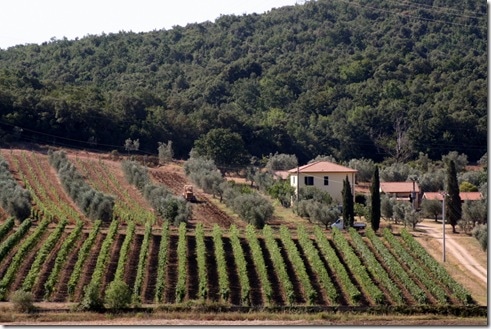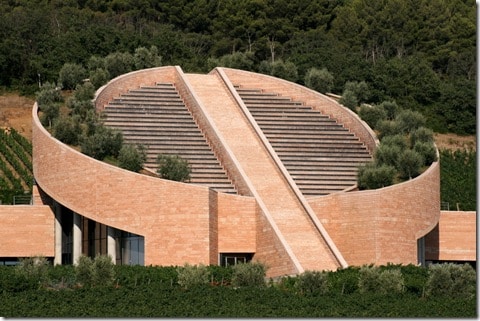Val di Cornia and Suvereto
This area like its famous neighbour to the north, Bolgheri, specialises in French grapes and a Tuscan take on Bordeaux. Not that there aren’t very good Sangiovese-based wines here, but they are in a minority. The drive towards quality was formally recognised by the promotion from DOC to DOCG status in November 2011 and came into force for the 2011-12 season.
Val di Cornia
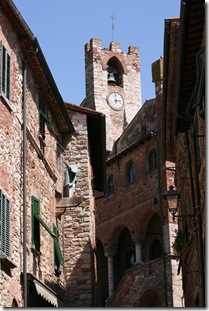 You can tell that the Val di Cornia is a relatively new quality wine area (DOC granted 1989) because, like Bolgheri, it has pretty flexible rules about which grapes you can include in designated wines. So, Val di Cornia Rosso DOCG must be at least 40% Sangiovese (it had been 50%) and after that can be any combination of Cabernet Sauvignon or Merlot and up to 20% of any other authorised red grape but not the aromatic Aleatico. Lots of flexibility here and note the provision for the use of large proportions of French grapes. This is a Tuscan DOCG but basically in a Super Tuscan mould. If you want to be entirely ST about it and are one of the concentration of wineries around Suvereto, there is Val di Cornia Suvereto DOCG which now allows up to 100% of Cabernet or Merlot or the two combined and allows up to 15% of other authorised varieties. (Suvereto was promoted to be its own DOCG in 2011.) As usual, there are also monovarietal options: Val di Cornia Cabernet Sauvignon (or any of the usual French or Tuscan varieties) which must be at least 85% of the named grape.
You can tell that the Val di Cornia is a relatively new quality wine area (DOC granted 1989) because, like Bolgheri, it has pretty flexible rules about which grapes you can include in designated wines. So, Val di Cornia Rosso DOCG must be at least 40% Sangiovese (it had been 50%) and after that can be any combination of Cabernet Sauvignon or Merlot and up to 20% of any other authorised red grape but not the aromatic Aleatico. Lots of flexibility here and note the provision for the use of large proportions of French grapes. This is a Tuscan DOCG but basically in a Super Tuscan mould. If you want to be entirely ST about it and are one of the concentration of wineries around Suvereto, there is Val di Cornia Suvereto DOCG which now allows up to 100% of Cabernet or Merlot or the two combined and allows up to 15% of other authorised varieties. (Suvereto was promoted to be its own DOCG in 2011.) As usual, there are also monovarietal options: Val di Cornia Cabernet Sauvignon (or any of the usual French or Tuscan varieties) which must be at least 85% of the named grape.
Links to featured wineries:
- Tua Rita – top quality Maremma
- Bulichella – high tech biological wines
- Gualdo del Re – established provider
- Russo – Southern wine-making know how
- Petra – the grandest gesture
- Jacopo Banti – history in the Val di Cornia
- Incontri – rustic warmth
The Val di Cornia has also been affected positively by Bolgheri in that, once suitable land in Bolgheri was exhausted, people began to look over the border to nearby areas to do more of the same. As a result, in the Val di Cornia, there is a mixture of locals making good and investment from near and far. The area runs from the coast at Piombino and then goes inland in a NE direction, around the main town of Suvereto, basically inland of the small spit of steep hills which separate it from Bolgheri on the coast.
Tua Rita – top quality Maremma
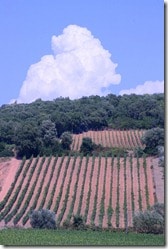
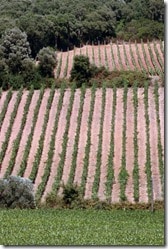 The Tuscan Maremma produces a great deal of attractive, fruity wine in a modern style. It doesn’t have quite enough super stars to raise its profile around the world. If you bracket Bolgheri from the equation, you could choose a handful, for example, Le Pupille in Scansano, Moris Farms in Massa Marittima and Castello del Terricio in Montescudaio. To these you can add Tua Rita, just below Suvereto.
The Tuscan Maremma produces a great deal of attractive, fruity wine in a modern style. It doesn’t have quite enough super stars to raise its profile around the world. If you bracket Bolgheri from the equation, you could choose a handful, for example, Le Pupille in Scansano, Moris Farms in Massa Marittima and Castello del Terricio in Montescudaio. To these you can add Tua Rita, just below Suvereto.
The estate has the same story as a number of wineries on these pages. Like Montevertine or Castello di Trebbio, it was bought as a country retreat but the production of quality wine turned into a serious if pleasurable business. The future retirement house was built in 1984, there was a hard winter in the following year which led to a lot of replanting at a dense 8-10,000 vines per hectare. By 1994 the winery was winning prizes at Vinitaly.
A new winery was built in 2000 with two fine underground air-conditioned halls for barriques. This level of investment is quite unusual for a relatively small grower of 30 hectares. This commitment to quality means that the benefits of reliable maturing of grapes in a reliably warm to hot climate can be combined with optimum conditions for ageing in wood. The winery also employed one of the best Italian enologists, Luca d’Atoma, who after a break has now returned to work with Tua Rita. Along with all the paraphernalia of modern winemaking, they have also invested in the support system which enables the barriques to be gently rolled in situ, promoting the malolactic fermentation and the good contact between lees and the developing wine. I am not too sure about the George and the Dragon motif but that doesn’t affect the quality of the wine which is uniformly high.
There is a second white produced, which we did not taste, Perlato del Bosco Bianco, made from the Maremman trio of Trebbiano, Ansonica and Vermentino, though rarely blended as here.
Rosso dei Notri, Rosso Toscana IGT, 2010 – which could be translated ‘local red’, as Notri is the name of the località where the estate is to be found. It is 50% Sangiovese and then a three-way split between Cabernet Sauvignon, Syrah and Merlot, the international varieties being aged for three months in wood. A very delicious baby Super Tuscan, if half Sangiovese, full of fruity red and blackberries flavours, simple and powerful.
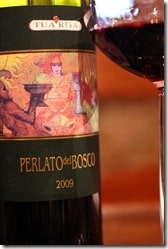 Perlato del Bosco Rosso, Rosso Toscana IGT, 2009 – a superb, grown-up version of the above, this time 60% Sangiovese and 40% Cabernet Sauvignon. This is made from the smaller berried Cabernet grapes with less dense bunches which are therefore riper and with a greater skin/juice ratio, giving more depth of flavour. The Cabernet is aged for 18 months in barriques, 70% of them new, but the Sangiovese is unoaked to preserve its fruit characteristics. Great balance with excellent depth of cherry and redcurrant to plum fruit; little leafiness on the nose but perceptible on the palate; tastes inviting and ‘light’ despite all the fruit; long finish. Although there is a large element of the international varieties in these last two wines, it is great to see a success being made of wines which are half or more Sangiovese in this relatively hot climate. Parker 90-94 points depending on the year, this scoring 93.
Perlato del Bosco Rosso, Rosso Toscana IGT, 2009 – a superb, grown-up version of the above, this time 60% Sangiovese and 40% Cabernet Sauvignon. This is made from the smaller berried Cabernet grapes with less dense bunches which are therefore riper and with a greater skin/juice ratio, giving more depth of flavour. The Cabernet is aged for 18 months in barriques, 70% of them new, but the Sangiovese is unoaked to preserve its fruit characteristics. Great balance with excellent depth of cherry and redcurrant to plum fruit; little leafiness on the nose but perceptible on the palate; tastes inviting and ‘light’ despite all the fruit; long finish. Although there is a large element of the international varieties in these last two wines, it is great to see a success being made of wines which are half or more Sangiovese in this relatively hot climate. Parker 90-94 points depending on the year, this scoring 93.
Giusto di Notri, Rosso Toscana IGT, 2009 – the estate’s Bordeaux blend, 60% Cabernet Sauvignon, 30% Merlot and 10% Cabernet Franc, fermented in large oak vats and matured for a year and a half in barriques in the first and second years of their brief careers. Very dense Cabernet aromas of blackcurrant and blackberry on the nose and palate, mouth-filling texture, had only just been bottled and really needs some time, excellent. Parker 90-97, the high tide mark being the 2001 vintage.
Syrah, Rosso Toscana IGT, 2009 – where there is a fine wine from international grapes in Tuscany, there is now Syrah. Again a tiny production, 1700 bottles in all, given the 200% new oak treatment, fermented in new barrels and then matured in another set of new barrels. Complex nose, obviously new wood notes on the nose of this very young wine, a profound palate of red fruit, liquorice, mint and spice, high acidity and rounded tannins, great potential. 93-97 P points – but then he would like this wouldn’t he!
Redigaffi Rosso Toscana IGT, 2008 – the top wine which is 100% Merlot and the one which made the estate’s name, a consistent winner of the top ‘three glasses’ award from the Gambero Rosso guide. The name comes from a small stream which crosses the property. The wine is fermented in oak vats and then matured in new barrels for 18 months, with some movement of the fine lees. Deep and dark, both in colour and in the extremely rich blackberry, mulberry and ripe cherry fruit; super luxury palate, weighty but intensely tactile – expensive velvet material comes to mind – a considerable ‘wow’ factor. 94-100 Parker points, the 2000 hit the heights.
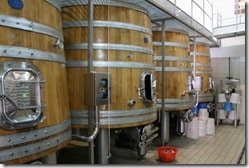
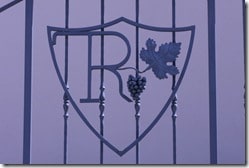
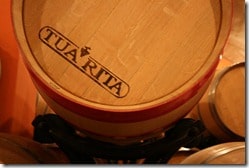
Tua Rita continues to be a standard-bearer for the Maremma, with its outstanding reds and innovative whites. Many thanks to Francesca for a great visit to a great place.
Bulichella – high tech biological wines
At Bulichella, two kilometres outside Suvereto, the investment is Japanese and the know-how Italian. The farm, which dates from 1983 but was completely renovated in 1997, is run biologically, looks beautiful because of all the attention lavished upon it and there is an agriturismo as well.
Alessandro, the wine maker, is understandably proud of the state-of-the-art technology at his disposal. In addition to the now usual temperature-controlled fermentation vessels, he also has the facility for micro-oxygenation and for keeping white musts at 0? centigrade. Yields are kept very low, down to one bunch per plant. The motto is that wine is made in the vineyard but the quality is kept in the winery. When we stayed here the plans for the future were very evident with new vineyards being prepared.
Tuscanio bianco 2006: 100% Vermentino. Pleasantly nutty and mineral; had just been bottled and so needed some time to mature. (All wines tasted 5/07)
Rubino 2005: Sangiovese 50%, Merlot and Cabernet Sauvignon 25% each. This quality red is matured for six months in barriques. This is the ‘calling card’ for the estate and is good value at €9. Lovely red fruit evident on the nose and palate, rounded easy drinking.
Tuscanio 2002: Sangiovese 90%, Merlot 10%, 15 months in barriques. Bulichella’s top Sangiovese put on a pretty good show in a miserable, rainy year. Lovely approachable fruit and signs of oak, good persistence.
Coldipietrerosse 2002: 80% Cabernet, 10% Merlot, 10% Petit Verdot (though the labels says its 20% Merlot!) The estate’s top wine is in a Super Tuscan style. The long name just means ‘the hill of the red rocks’. Deep red in colour, excellent nose of blackberries and oak, sweet and rounded, decent structure, moderate persistence. The 2006 vintage is well received by L’espresso 2010.
Aleatico 2005: qualcosa particolare said Alessandro and indeed it was something a bit special. This is the sweet dessert wine of Elba and Tuscany, made from the perfumed Aleatico grape. Aromas of prunes, dried grapes, grapefruit, very drinkable, definitely not dry but not sickly sweet. Would be good with both cheese and desserts.
Gualdo del Re – established provider
On the small Forni road, south of the town of Suvereto, there is an impressive line up of wineries, a good dozen. The most prestigious is undoubtedly Tua Rita (to be visited still), but there is also Gualdo del Re, Russo and others. Gualdo del Re is well-established and produces 100,000 bottles a year. Its history goes back into the nineteenth century though the first modern harvest was 1982. They produce an interesting range of wines. We tasted five of the ten wines in 5/07. (They are one of the few to try Pinot Nero in the region but I haven’t tasted that.)
Valentina 2006: 100% Vermentino, banana and herbs on the nose, good
Strale 2004: classified as IGT Bianco Toscano, as the grapes are Pinot Bianco, this white is oaked, the malolactic fermentation taking place in barriques. Golden tinges in the glass, vanilla and some herbiness on the nose, mildly aromatic, good mouth feel. Good with the famous Tuscan soups – chick pea, mushroom or mussels – and the aperitivo wine of Suvereto’s specialist fish restaurant, Ristorante dal Cacini.
All the quality reds spend a year in barriques and a year in bottles before release:
Gualdo del Re 2002, 100% Sangiovese, a big wine, 14% alcohol. Great nose of dark fruits and well-integrated oak, cherry, figs, liquorice. A very good example of warm climate, Maremman Sangiovese. Not for the very long keeping but creditable in wet 2002.
Frederico I 2002: Cabernet Sauvignon, deep garnet red, big concentration of fruit.
I’Rennero 2002: 100% Merlot, 15 months in barriques, 21 months in bottle before release. Described by the winery as the king of its reds, its a brighter red than Frederico I and tasted of blackberries and mulberries, lovely rounded fruit, great concentration, the sweetness of ripe fruit.
Summer 2012 update
We had the chance to taste some recent vintages in August 2012 at the property:
Sangiovese 2009 – this is a serious wine which is given 15 months in barriques with a production of 10,000 bottles. It is the only top quality wine not to have a special name – Sangiovese is special enough. Well structured, good depth of cherry and plum fruit, good persistence and superb balance. The last-named is not easy to achieve with Sangiovese in the heat and lack of altitude of the Val di Cornia.
Federico Primo 2007 – being Cabernet Sauvignon in purezza. Powerful but subtle, well-articulated fruit ranging from redcurrant to blackberry. This spends 18 months in barriques, a mixture of one to three-year-olds. Good structure, very good persistent fruit above liquorish and chocolate notes.
Gualdo del Re is going from strength to strength.
Russo – Southern wine-making know how
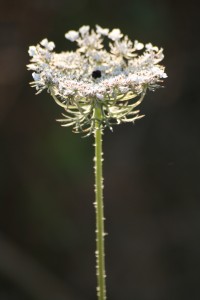 If you keep going on the Forni road, long after you appear to have left the wineries which huddle together for company, keep going past some industrial landscape, eventually go up a farm track you come to a very ordinary-looking farm, the home of the Russo brothers. They are originally from Campania, from a winemaking family. As a relatively small concern, Russo has made an impact on the Tuscan scene and beyond. Antonio Russo and his welcoming wife greeted us warmly and gave us the history of this farm on which they had their first vintage in 1998. 14 hectares of vines are kept company by 7 of olives and 70 milk cows – plenty to keep the two brothers, their families and two regular farmhands busy. We sat in a simple room in the house which doubles as a tasting room and enjoyed:
If you keep going on the Forni road, long after you appear to have left the wineries which huddle together for company, keep going past some industrial landscape, eventually go up a farm track you come to a very ordinary-looking farm, the home of the Russo brothers. They are originally from Campania, from a winemaking family. As a relatively small concern, Russo has made an impact on the Tuscan scene and beyond. Antonio Russo and his welcoming wife greeted us warmly and gave us the history of this farm on which they had their first vintage in 1998. 14 hectares of vines are kept company by 7 of olives and 70 milk cows – plenty to keep the two brothers, their families and two regular farmhands busy. We sat in a simple room in the house which doubles as a tasting room and enjoyed:
Pietrasca 2008: mainly Vermentino, but with a little bit of Clairette and Chardonnay, from a very good year, excellent perfume, herby, floral, less nutty than some, very fresh and drinkable. This wine, like most of theirs, is named after the locality in which it grows.
Ceppitaio 2007: Sangiovese, Colorino, Cannaiolo, Ciliegiolo, Merlot and Cabernet grapes, some bought in. Again good fragrance, quite rounded, good, highly drinkable wine. Named after the yellow flowered perennial plant (Inula viscosa) that grows in the fields.
Barbicone 2006: The top red. 80% Sangiovese plus other typical varieties of the region, Ciliegiolo, Colorino, Cannaiolo and Giacomino, from 40 year old vines. Antonio laughs – “whose knows what the other grapes are? I rent the vineyard from a shepherd and it’s just what’s in the field”. After 18-20 days of maceration, the wine is left on the lees, and then aged in barriques in their second and third year of use. 2006 is an excellent year – ripe fruit, moderate oak, dense, some liquorish. An excellent 17/20 score in L’espresso for a wine that costs less than €20. 2005: surprisingly dark colour (for the pale Sangiovese grape), good use of oak and dense red fruit, rounded and sophisticated on the palate, notes of chocolate and tobacco, very superior (7/08). Recommended at the very fine friendly and knowledgeable Le Volte restaurant (with rooms and wine bar), Casale Marittimo.
There is also the Merlot/Cabernet Sauvignon blend Sassobucato, named after a disused marble mine next to the vineyard.
We leave after a wonderful meeting and tasting. Some corks have been delivered. Portuguese according to the labelling – “how many corks trees are there in Portugal?” asks Antonio with the same knowing laugh.
Petra – the grandest gesture
The Petra winery, built from 1997, is worth visiting, even if you are not interested in wine. The eye-catching, tambourine-at-45% building, topped by full sized olive trees, demands to be noticed. As its owners are all too aware, people have not heard of Suvereto in Milan, never mind New York or London. Despite its huge presence, the new winery sits well in the landscape, complemented by the sea of vines in front of it and the charming, old winery building looking on in apparent quiet contentment.
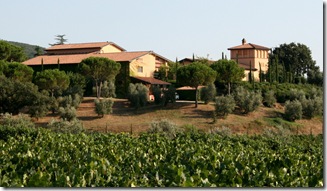
Designed by Swiss architect Mario Botta, the spectacular pale pink construction, model vineyard and exciting interior make the new winery an architectural landmark in contemporary Tuscany. Mind you its owners, the Moretti, have had a bit of practice. In addition to making excellent sparkling wine up north at Bellavista in Franciacorta, the main business has been pre-cast concrete and laminated wood buildings. This was the company’s 122nd winery. You tell Sig. Moretti where you would like your winery and he will put it up in three months.
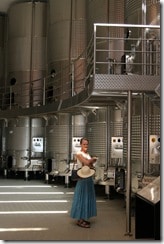
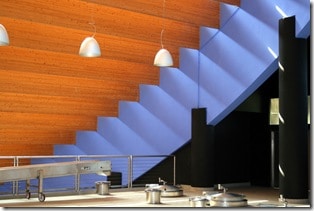
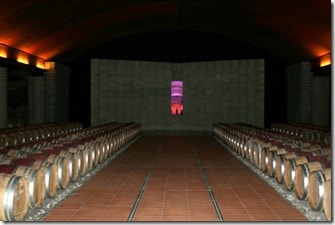
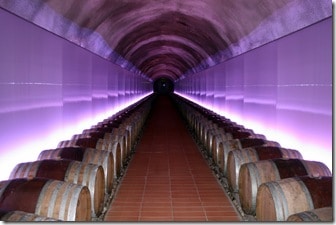
The barricaia makes the most of the hillside location, going deep into the rock. The bottling and packing plant on the lowest floor completes the journey from basket of grapes to bottle ready for sale. The bottling line can handle the 22,000 bottles produced in each batch in a single operation, eliminating the need to store wine temporarily or repeatedly clean equipment. Production in 2007 was 280,000 bottles, with the eventual target of 500,000. The vineyards stretch out in front of the winery with additional sites by the sea at Follonica and at 300m of altitude at Massa Marittima.
The top wine, Petra, is fermented in large, wooden vessels with higher temperatures and longer maceration times (25 days).
Tasting takes place in another, relaxed old building, which serves as shop and reception centre for the 4,000 visitors a year. Four red wines are produced:
Zingari 2006: Merlot, Sangiovese, Syrah, Alicante, presumably what was in the vineyards when they bought the estate. A fresh, drinkable style, made for drinking young, slightly wild edges to it.
Ebo 2004: Cabernet Sauvignon 50%, Sangiovese 30%, Merlot 20%. This is the quality red, made in large quantities, vinified in the enormous stainless steel containers, matured in old barriques for 12 months with a six-month rest in bottles before release. Big blackcurrant nose, black fruits, rounded, moderate length.
Quercegobbe: IGT Toscana, Merlot, from a single vineyard (‘hunched back’), which gets the influence of the sea, fermented in large wood containers, matured in 600-litre barrels and second year barriques for 15 months. 2004: A good year and a good example of Maremman Merlot, rich fruit, good acidity. (tasted 7/07) 2005: a demanding year and a wine in development still, pronounced asparagus and capers aromas on the nose to start with, then some red and black fruit, rounded and approachable, finally quite chocolately – rather an extraordinary experience, given the rapid changes in the aroma profile of the wine. (8/09) 2006: an excellent year, not ‘green’ at all, excellent if young fruit, high tannins and acidity, needs time but has great potential. (8/09)
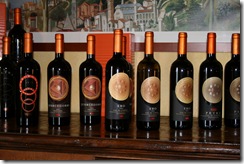
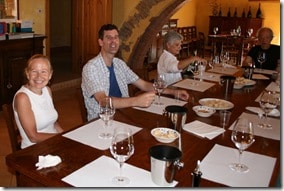
Jacopo Banti – history in the Val di Cornia
The Val di Cornia has become a sort of southern extension of Bolgheri, better known for its substantial, well-priced Super Tuscan wines than for local varietals. But of course, there was winemaking on this part of the Tuscan coast before the big money arrived and the hope of international recognition. In many ways, Jacopo Banti represents that earlier history. It is a family farm on the hillside which falls away from the town of Campiglia Marittima, 30 minutes south of Bolgheri by car. Founded back in 1931, Its first claim to fame was that it was the first winery in the Val di Cornia to bottle wine in the 1950s, a sign of real ambition and forward-thinking. Having led the field with exports to Germany from 1958, by today’s standards the plant now looks rustic and homely. The commitment today is to certificated biological agriculture and to the conservation of their vinous heritage.
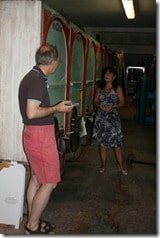
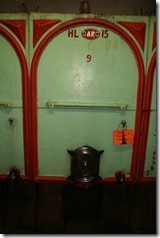

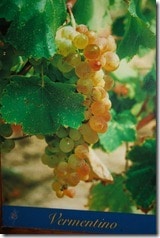
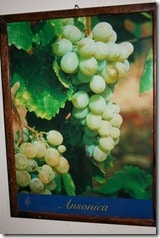
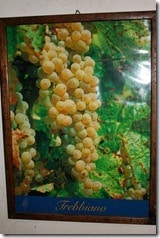
The two versions of Ciliegiolo (one of Sangiovese’s parents) are strongly contrasting. Ceragiolo 2010 is 100% of the variety and its name is the closest you can get without actually using the name of the variety. The wine is all about beautiful, fresh, sour cherry fruit with the bonus that its tannins are lower than its famous offspring. Medium weight, straightforward drinking pleasure. In a more ‘serious’ vein, Trafui 2008 spends between one and two years in used barriques and majors on plum and tobacco notes. The name recalls the pain and confusion of trying to learn Italian grammar properly – fui, fosti, fu is the literary form of the past tense of ‘to be’ in Italian, little used in everyday speech in central Italy but a sign of successful (or otherwise) education. The wine recalls the past …
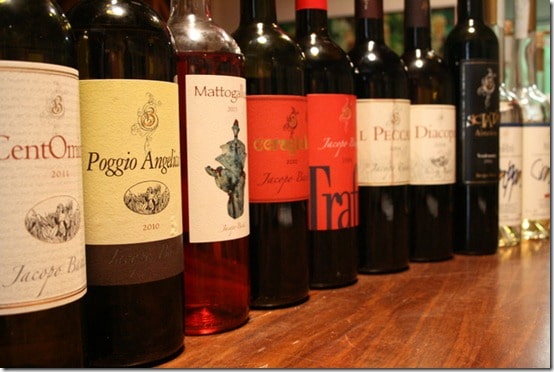
With many thanks to Manuela and all at Jacopo Banti – I am really encouraged by the way you are promoting the old Tuscan varieties.
Incontri – rustic warmth
Our visit to Incontri, below Suvereto, took place on the sort of hot and humid day in the summer of 2012 that might better be devoted to the beach or at least keeping out of the heat. Quite a few wineries in the Val di Cornia have broken into the international market while others have continued to be small, family-based concerns serving local needs and the ‘teutonic tourist driver’ market – fill up a large car with a few cases after a week or two on the beach or in the countryside before driving back to Stuttgart or Basel. Incontri, with its 12 hectares, bed and breakfast business and rustic outbuildings is one of the latter.
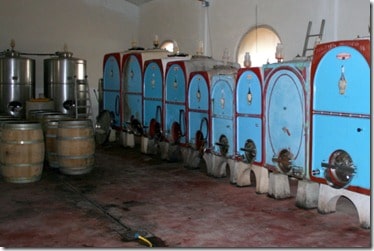
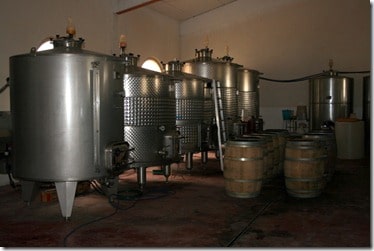
Visiting the winery in the large, barn-like structure, is, however, instructive as you can see before your eyes the various phases of investment in a small business. In the top picture above is the now rather cute, painted, cement fermentation vessels (complete with fiasco decoration) which will have seemed so state of the art forty years ago, while lower picture you can see two generations of stainless steel vats, with different cooling systems. The style of the wine is wholesome (certified organic viticulture; natural yeasts being used for fermentation) and bold – big, quite structured wines with lots of fruit in the reds. As the main winemaker was not around for most of our visit and the website is basic, the winemaking notes here are uneven.
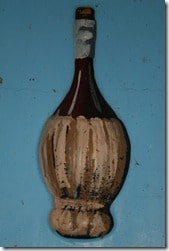 Ildobrandino, Val di Cornia DOC Vermentino, 2009 – this wine is part-fermented in barriques so it is an attempt at a more structured wine. No sulphur dioxide is added along the way. Leads with citrus (orange) and leafy aromas with a hint of sweetness; rich and expansive on the palate, the citrus being joined by apricot flavours. Well balanced, very good.
Ildobrandino, Val di Cornia DOC Vermentino, 2009 – this wine is part-fermented in barriques so it is an attempt at a more structured wine. No sulphur dioxide is added along the way. Leads with citrus (orange) and leafy aromas with a hint of sweetness; rich and expansive on the palate, the citrus being joined by apricot flavours. Well balanced, very good.
Martellino degli Incontri Bianco, Val di Cornia DOC, 2010 – 60% Vermentino, 40% Trebbiano, unoaked: full-bodied, characterful, citrus, grass and peach on nose and palate. Named after grandfather Martellino who kept the farm going in the middle of the last century when the great flight from the land took place.
Martellino degli Incontri Rosso, Val di Cornia Sangiovese DOC 2008 – 85% Sangiovese, 15% Merlot, picked early to retain its excellent acidity; simple, intense red and black fruit, clean and fruit-forward.
Lorenzo, Val di Cornia Suvereto Sangiovese DOC 2008 – 95% Sangiovese, backed up with 5% Cabernet and Merlot: rich black fruit already developing olive, leather and farmyard aromas; substantial volume in the mouth, good smooth finish.
Merlò, Val di Cornia Merlot DOC, 2008, 15.5% – I did not routinely record the alcohol levels of these wines which will have been 14% and more but this one was a big hitter. Incontri make small numbers of these monovarietal wines and lavish extra care on them. Super rich, balsam and black fruit nose, intense plum to prune palate, good balance, medium length.
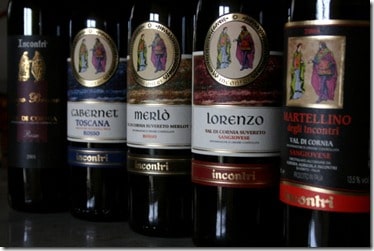 Cabernet IGT Toscana 2008 – less expressive to start with but then rich and alcoholic on the palate, black fruit, less intense than the Merlot. Picked very late – middle of October which contributes to the full ripeness and high alcohol.
Cabernet IGT Toscana 2008 – less expressive to start with but then rich and alcoholic on the palate, black fruit, less intense than the Merlot. Picked very late – middle of October which contributes to the full ripeness and high alcohol.
Lago Bruno, Val di Cornia Suvereto 2007 – a 50/50 Cabernet/Merlot blend which spends two years in barriques. Very elegant aromas with real depth (ripe blackberry, hint of chocolate, liquorice), the rich fruit with excellent balance with a clean, long finish. Just 2,000 bottles made, €16 at the winery, something of a bargain. We also tasted the remnants of a bottle of 2001 which had been open for a day or two and admired its rich, prune and leather complexity.
As they say, you can’t tell a book by its cover. Incontri is one of the less glamorous wineries in the relatively new prosperity of Suvereto but it produces robust, characterful wines which faithfully reflect the warmth of the Tuscan Maremma.
Some other wineries:
The Val di Cornia took a good step by having a stand at the London International Wine Fair, May 2010. The size of the marketing mountain was well illustrated by the people on the stand telling me that I was the first visitor who knew where the Val di Cornia was. But others were impressed by the wines, so there is lots to celebrate here. I mainly focused on Sangiovese and enjoyed:
- the white Stradivino 2009, Rigoli: nice fresh lemony 100% Vermentino, quite complex
- Rodantonio 2006, Sangiovese (100%), I thought there was quite a lot of oak but said to be 2nd/3rd year barrels, pleasant, very modern and fruit led in style, quite rich and persistent
- San Guisto Rosso 2005, 100% Sangiovese, a little bit dumb on the nose but then dark cherry-plum fruit, good – from right down on the coast at Piombino with no doubt great views of Elba
- Libatio Lunae, Sant’Agnese, 2004, also near Piombino. This top Sangiovese is fermented in open vats with regular pressing down, maceration for 8-10 days, matured for 18 months in barriques: great depth of flavour, excellent acidity from a top year, complex, very good indeed – and shows you can make quality Sangiovese on the coastal strip.
Next: Montescudaio

